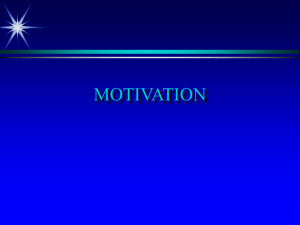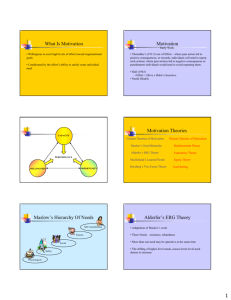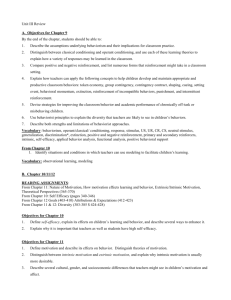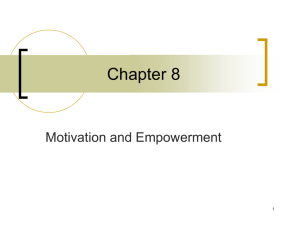Motivation Slides
advertisement
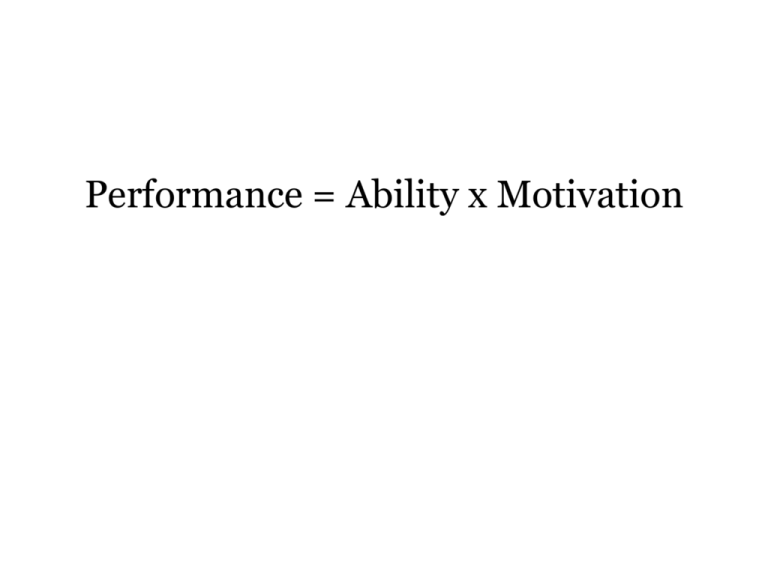
Performance = Ability x Motivation Maslow’s Need Hierarchy Self-Actualization Self-Esteem Needs Social Needs Safety Needs Basic needs Physiological Needs Equity Theory Social comparison process where motivation is due to perceptions of inequity Person Comparison Other (forms a ratio of (can be a co-worker, inputs to yourself in the past, outcomes and an ideal) compares this ratio to a comparison other) Inputs (e.g., experience, effort, skill, education) Outcomes (e.g., $, benefits, flexibility, autonomy, responsibility, promotion) Equity Theory Example Overpayment (receiving greater outcomes to inputs compared to another) Underpayment (receiving less outcomes to inputs compared to another) Person: 50/75 Person: 50/50 Other: Other: 50/50 50/75 Result: Result: Hourly work (salaried position) : Hourly work (salaried position): Greater input (e.g., effort) to reduce the perceive inequity regarding the quantity and quality of goods Less input (e.g., effort) to produce less number and poorer quality of goods Piece rate: Greater input to produce better quality goods Piece rate: Greater input to produce more quantity of goods but with less quality Inequity Options Behavioral Options to reduce perceived inequity: 1) Change outcomes (e.g., ask for a raise) 2) Get other to change their inputs to outcomes (e.g., slow down their rate of production 3) Find new work (e.g., quit the job, get a job transfer) Cognitive Options to reduce perceived inequity: 1) Distort one’s own inputs or outcomes (e.g., “I’m not really working that hard,” “I have a lot of free time”) 2) Distort the inputs or outcomes of others (e.g., he/she gets more money than me but they have to live in Buffalo) 3) Change the comparison other Expectancy Theory Rewards (Outcomes) Pay Work Conditions Valences (attractiveness of outcomes rated on a scale from -10 to +10. A valence is given to each job outcome) 7 (the perceived relationship between performance and attained outcomes from 0 to 1.0. One .75 instrumentality for each .50 valence) .30 3 .10 9 6 Benefits Autonomy Instrumentality Expectancy (perceived relationship between effort and performance; 0 to 1.0. There is only one expectancy value) Motivation force = (V x I) + (V x I) + (V x I) + (V x I) x E Reinforcement Theory Stimulus Response Reinforcement Schedules of Reinforcement • Fixed Interval (FI) e.g., reinforcement by the hour or week • Fixed Ratio (FR) e.g., reinforce based on piece rate on the number of goods produced, behaviors performed • Variable Interval (VI) e.g., reinforcement based on random passage of time • Variable Ratio (VR) e.g., random (variable) reinforcement based on the number of goods produced, behaviors performed (such as gambling) Goal Setting Goal Awareness Goal Acceptability Knowledge of behaviors needed to achieve goals It is best for goals to be: • Challenging (difficult) • Specific Feedback Reasons Why Goals Setting Works (Mechanisms) • Directs actions of employees • Aids in the development of strategies • Energizes actions/behaviors Fulfilling valued goals leads to self-satisfaction and creates incentives to intensify efforts • Promotes persistence Possible Limitations: • Competition • Production of undesirable behaviors (e.g., unethical, not reporting goal-damaging behaviors) • Focus on certain performance criteria (e.g., quantity vs. quality) ~ Some Goal Setting Issues~ • Effectiveness of assigned versus participative goal setting a) Role of authority figure b) Creation of confidence in employees (high self-efficacy) c) Creates challenge d) Helps to define standards for employees • Role of goal acceptability and difficult goals (low expectancy goals; one’s where the probability for success is low) • Satisfaction (easy goals) versus motivation (difficult goals) a) Use of moderately difficult goals b) Different points used for easy and difficult goals c) Make goals incrementally more difficult (accomplishing earlier, easier goals can lead to satisfaction) Interaction of goal setting and feedback (One without the other does not work) Goal Setting Model Moderating Factors Goal Commitment Feedback Ability Task Complexity Situational constraints Specific, High Goals High Expectancy Self-Efficacy Mediating Mechanisms Effort Persistence Direction Task Strategies (plans) High Performance Contingent & Non-Contingent Rewards Satisfaction (and anticipated satisfaction) Commitment to the Organization and its Goals Self-Efficacy: Beliefs about one’s capabilities to produce a desired level of performance and to control events “Whether you think you can or you can’t, you’re usually right.” --- Henry Ford “If I have the belief that I can do it, I shall surely acquire the capacity to so it even if I may not have it at the beginning.” --- Mahatma Gandhi “A man who doubts himself is like a man who would enlist in the ranks of his enemies and bear arms against himself. He makes his failure certain by himself being the first person to be convinced of it.” --- Alexandre Dumas “Self confidence is the first requisite to great undertakings.” --- Samuel Johnson Sample Self-Efficacy Items • I can always manage to solve difficult problems if I try hard enough • I someone opposes me, I can find means and ways to get what I want. • It is easy for me to stick to my aims and accomplish my goals. • I am confident that I could deal efficiently with unexpected events. • Thanks to my resourcefulness, I know how to handle unforeseen situations. • I can solve most problems if I invest the necessary effort. • I can remain calm when facing difficulties because I can rely on my coping abilities. • If I am confronted with a problem, I can usually find several solutions. • If I am in trouble, I can usually think of something to do. • No matter what comes my way, I’m usually able to handle it. Feelings Thoughts Perceived self-efficacy Motivation Behavior Failure: Attributions, resilience, effort, and future goal levels Bulk of motivation is due to our thoughts about what we can do, and the anticipation of the likely outcomes of our behaviors Job Characteristics Model Critical Psychological States Core Job Dimensions Personal & Work Outcomes Combine Tasks Skill Variety Task Identity Task Significance Autonomy Put tasks into natural work units Customer contact Meaningfulness of work • High intrinsic work motivation • High quality of work performance Vertically load jobs Feedback Open feedback channels Responsibility for work outcomes Knowledge of work results • High satisfaction with work • Low absenteeism and turnover Employee Growth Need Strength Motivation Potential Score = (Skill variety + Task identity + Task significance) /3 x Autonomy x Feedback Sample Questions From The Job Diagnostic Survey • How much autonomy is there in your job? That is, to what extent does your job permit you to decide on your own how to go about doing the work? 1 2 Very little; the job gives me almost no personal “say” about how and when the work is done 3 4 5 6 Moderate autonomy; many things are standardized and not under my control, but I can make some decisions about the work 7 Very much; the job gives me almost complete responsibility for deciding how and when the work is done • How significant or important is your job? That is, are the results of your work likely to significantly affect the lives or well-being of other people? 1 2 3 Not very significant; the outcomes of my work are not likely to have important effects on other people 4 5 6 Moderately significant 7 Highly significant; the outcomes of my work can affect other people in very important ways • To what extent do managers and co-workers tell you how well you are doing on your job? 1 Very little; people almost never let me know how well I am doing 2 3 4 Moderately; sometimes people may give me “feedback,” other times they may not 5 6 7 Very much; managers or coworkers provide me with almost constant “feedback” about how well I’m doing Developing Self-Determination “Intrinsically motivated behavior is by definition self-determined. It is done freely for the inherent satisfaction associated with certain activities and with undertaking optimal challenge” (Deci & Ryan, 1987) Motivation: SDT What/where are people’s motivational incentives? Extrinsic Motivation The gains we make from the activity motivate us (e.g., money, power, prestige, endorsements) Intrinsic Motivation The activity itself is rewarding; you are interested, and enjoy doing it A Look at Rewards for Motivation • Good jump ropers during recess were chosen and put in three conditions. • Following the intervention, which group will jump rope during recess more? Expected reward: Unexpected reward: Control / No reward: Students were told if they did a good job, they would get a “good jumper” badge. All got a badge. Students were awarded a “good jumper” badge after doing a good job on the task. All got a badge. Students jumped rope, but were not told of a reward, and were not given one. Intrinsic Motivation Overall Motivation = Internal + External Rewards Individuals who intrinsically enjoy their work Why? Increase extrinsic (external) rewards (e.g., pay) Intrinsic Motivation Extrinsic Motivation Can lead to lowered intrinsic motivation • Extrinsic (external) factors now partially account for why individuals are motivated to perform a given task • External rewards limit people’s sense of self-determination Tangible extrinsic rewards reliably undermine intrinsic motivation under most circumstances. The most detrimental reward contingency involves giving rewards as a direct function of people's performance. This is the one most often used in life, seems to be the one that is most detrimental to the motivation, performance, and well-being. http://www.psych.rochester.edu/SDT/cont_reward.html
